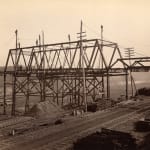[Norfolk and Western Railway]
Group of Photos Showing Railroad Construction in West Virginia, 1880s-90s
Albumen prints and cyanotypes (48)
Most 5 x 8 inches (20) or 7 1/2 x 9 3/4 inches (27), one smaller
Some with manuscript notations verso.
Some with manuscript notations verso.
Further images
-
(View a larger image of thumbnail 1
)

-
(View a larger image of thumbnail 2
)

-
(View a larger image of thumbnail 3
)

-
(View a larger image of thumbnail 4
)

-
(View a larger image of thumbnail 5
)

-
(View a larger image of thumbnail 6
)

-
(View a larger image of thumbnail 7
)

-
(View a larger image of thumbnail 8
)

-
(View a larger image of thumbnail 9
)

-
(View a larger image of thumbnail 10
)

-
(View a larger image of thumbnail 11
)

-
(View a larger image of thumbnail 12
)

This collection of photographs documents the expansion of the Norfolk and Western Railway line in West Virginia in the late 1880s and early 1890s.with several images showing the construction of...
This collection of photographs documents the expansion of the Norfolk and Western Railway line in West Virginia in the late 1880s and early 1890s.with several images showing the construction of the company’s eponymous railroad bridge.
While the Norfolk and Western Railway (N&W) didn’t exist under that name until 1880, the 200-odd railroad mergers that led to and followed its creation began in 1838. Headquartered in Roanoke, Virginia, N&W was known as “King Coal” and “British Railway of America.” The latter moniker came, in part, from the company’s habit of manufacturing its own steam locomotives. While unusual in the United States, the practice was common in the U.K.
In 1885, N&W purchased the Flat-Top Coal Land Association, reorganizing it as the Pocahontas Coal and Coke Company (PCCC). The bituminous coal mined in the region quickly became famous for its quality, and the business exploded. The following year, N&W extended its tracks to coal piers at Lambert’s Point, giving the company near-complete control over every aspect of the process.
There are fifteen photographs, including a number of richly-printed cyanotypes, which document the construction of the Norfolk & Western Railroad Bridge at Kenova. Construction on the bridge began in 1890, as part of N&W’s work on a new line connecting Norfolk, Virginia to Cincinnati, Ohio. Construction took 23 years, flooding the area with laborers and a town to meet their needs.
Other identified views include a trestle in Elkhorn; Freeman & Jones’ Coal Tipple, Simmon’s Creek; Alderson’s Coke ovens switch back; and Hamilton coke ovens, Elkhorn.
N&W continued operations until 1982, when N&W was absorbed into Norfolk Southern Railway.
While the Norfolk and Western Railway (N&W) didn’t exist under that name until 1880, the 200-odd railroad mergers that led to and followed its creation began in 1838. Headquartered in Roanoke, Virginia, N&W was known as “King Coal” and “British Railway of America.” The latter moniker came, in part, from the company’s habit of manufacturing its own steam locomotives. While unusual in the United States, the practice was common in the U.K.
In 1885, N&W purchased the Flat-Top Coal Land Association, reorganizing it as the Pocahontas Coal and Coke Company (PCCC). The bituminous coal mined in the region quickly became famous for its quality, and the business exploded. The following year, N&W extended its tracks to coal piers at Lambert’s Point, giving the company near-complete control over every aspect of the process.
There are fifteen photographs, including a number of richly-printed cyanotypes, which document the construction of the Norfolk & Western Railroad Bridge at Kenova. Construction on the bridge began in 1890, as part of N&W’s work on a new line connecting Norfolk, Virginia to Cincinnati, Ohio. Construction took 23 years, flooding the area with laborers and a town to meet their needs.
Other identified views include a trestle in Elkhorn; Freeman & Jones’ Coal Tipple, Simmon’s Creek; Alderson’s Coke ovens switch back; and Hamilton coke ovens, Elkhorn.
N&W continued operations until 1982, when N&W was absorbed into Norfolk Southern Railway.
![[Norfolk and Western Railway], Group of Photos Showing Railroad Construction in West Virginia, 1880s-90s](https://artlogic-res.cloudinary.com/w_1600,h_1600,c_limit,f_auto,fl_lossy,q_auto/artlogicstorage/dollc/images/view/878cc3e49a2cf936492f894d998d7a63j/daniel-oliver-norfolk-and-western-railway-group-of-photos-showing-railroad-construction-in-west-virginia-1880s-90s.jpg)
![[Norfolk and Western Railway], Group of Photos Showing Railroad Construction in West Virginia, 1880s-90s](https://artlogic-res.cloudinary.com/w_1600,h_1600,c_limit,f_auto,fl_lossy,q_auto/artlogicstorage/dollc/images/view/b5a7877508f8475446c379b542e86d4ej/daniel-oliver-norfolk-and-western-railway-group-of-photos-showing-railroad-construction-in-west-virginia-1880s-90s.jpg)
![[Norfolk and Western Railway], Group of Photos Showing Railroad Construction in West Virginia, 1880s-90s](https://artlogic-res.cloudinary.com/w_1600,h_1600,c_limit,f_auto,fl_lossy,q_auto/artlogicstorage/dollc/images/view/1e27848462f826ad0cb3695941f788a5j/daniel-oliver-norfolk-and-western-railway-group-of-photos-showing-railroad-construction-in-west-virginia-1880s-90s.jpg)
![[Norfolk and Western Railway], Group of Photos Showing Railroad Construction in West Virginia, 1880s-90s](https://artlogic-res.cloudinary.com/w_1600,h_1600,c_limit,f_auto,fl_lossy,q_auto/artlogicstorage/dollc/images/view/bf2ed46bfd6f777c64c71f4fc672503aj/daniel-oliver-norfolk-and-western-railway-group-of-photos-showing-railroad-construction-in-west-virginia-1880s-90s.jpg)
![[Norfolk and Western Railway], Group of Photos Showing Railroad Construction in West Virginia, 1880s-90s](https://artlogic-res.cloudinary.com/w_1600,h_1600,c_limit,f_auto,fl_lossy,q_auto/artlogicstorage/dollc/images/view/9fd7e0dd34a19949bc77f96209eda644j/daniel-oliver-norfolk-and-western-railway-group-of-photos-showing-railroad-construction-in-west-virginia-1880s-90s.jpg)
![[Norfolk and Western Railway], Group of Photos Showing Railroad Construction in West Virginia, 1880s-90s](https://artlogic-res.cloudinary.com/w_1600,h_1600,c_limit,f_auto,fl_lossy,q_auto/artlogicstorage/dollc/images/view/4c142996176e047899f924e839833a33j/daniel-oliver-norfolk-and-western-railway-group-of-photos-showing-railroad-construction-in-west-virginia-1880s-90s.jpg)
![[Norfolk and Western Railway], Group of Photos Showing Railroad Construction in West Virginia, 1880s-90s](https://artlogic-res.cloudinary.com/w_1600,h_1600,c_limit,f_auto,fl_lossy,q_auto/artlogicstorage/dollc/images/view/71fe64daef6b3a98044e29cfa7ab9652j/daniel-oliver-norfolk-and-western-railway-group-of-photos-showing-railroad-construction-in-west-virginia-1880s-90s.jpg)
![[Norfolk and Western Railway], Group of Photos Showing Railroad Construction in West Virginia, 1880s-90s](https://artlogic-res.cloudinary.com/w_1600,h_1600,c_limit,f_auto,fl_lossy,q_auto/artlogicstorage/dollc/images/view/9ac30b1699e94bb472c95c8f01c057ebj/daniel-oliver-norfolk-and-western-railway-group-of-photos-showing-railroad-construction-in-west-virginia-1880s-90s.jpg)
![[Norfolk and Western Railway], Group of Photos Showing Railroad Construction in West Virginia, 1880s-90s](https://artlogic-res.cloudinary.com/w_1600,h_1600,c_limit,f_auto,fl_lossy,q_auto/artlogicstorage/dollc/images/view/63965047d4fde40c33a18cf06e21930aj/daniel-oliver-norfolk-and-western-railway-group-of-photos-showing-railroad-construction-in-west-virginia-1880s-90s.jpg)
![[Norfolk and Western Railway], Group of Photos Showing Railroad Construction in West Virginia, 1880s-90s](https://artlogic-res.cloudinary.com/w_1600,h_1600,c_limit,f_auto,fl_lossy,q_auto/artlogicstorage/dollc/images/view/77e5e2a0f7422043cf8d0954b2be25d4j/daniel-oliver-norfolk-and-western-railway-group-of-photos-showing-railroad-construction-in-west-virginia-1880s-90s.jpg)
![[Norfolk and Western Railway], Group of Photos Showing Railroad Construction in West Virginia, 1880s-90s](https://artlogic-res.cloudinary.com/w_1600,h_1600,c_limit,f_auto,fl_lossy,q_auto/artlogicstorage/dollc/images/view/4264a050677ddbf5494b643ac61dda5dj/daniel-oliver-norfolk-and-western-railway-group-of-photos-showing-railroad-construction-in-west-virginia-1880s-90s.jpg)
![[Norfolk and Western Railway], Group of Photos Showing Railroad Construction in West Virginia, 1880s-90s](https://artlogic-res.cloudinary.com/w_1600,h_1600,c_limit,f_auto,fl_lossy,q_auto/artlogicstorage/dollc/images/view/0674c6e0fa0bca5f26450acfe953ebc1j/daniel-oliver-norfolk-and-western-railway-group-of-photos-showing-railroad-construction-in-west-virginia-1880s-90s.jpg)